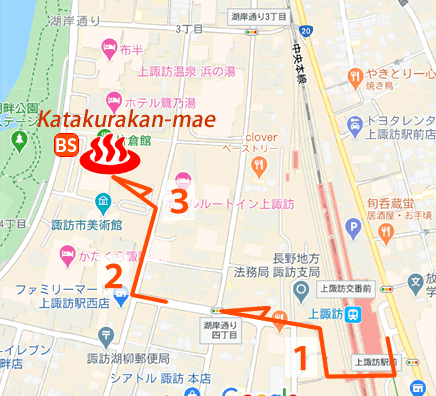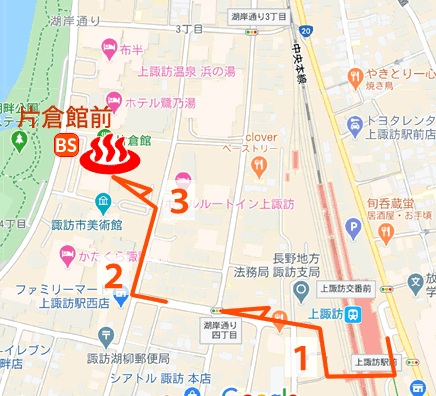4-1-9, Kogandori, Suwa City, Nagano Pref.
A valuable experience that allows you to take a bath in the important cultural property! A romantic hot spring filled with beautiful tiles and sculptures
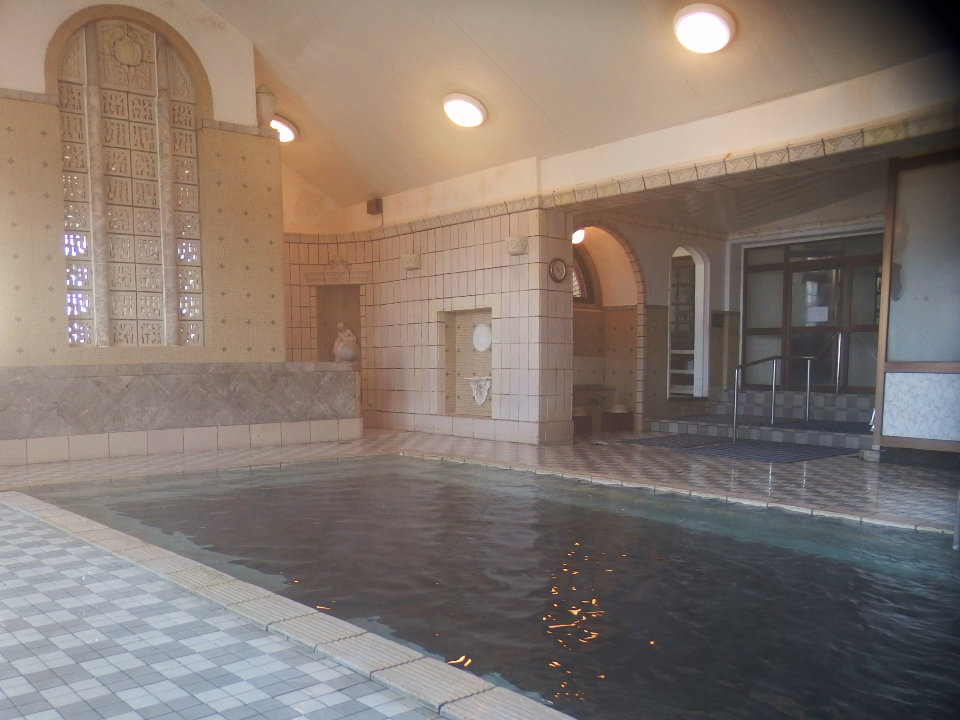
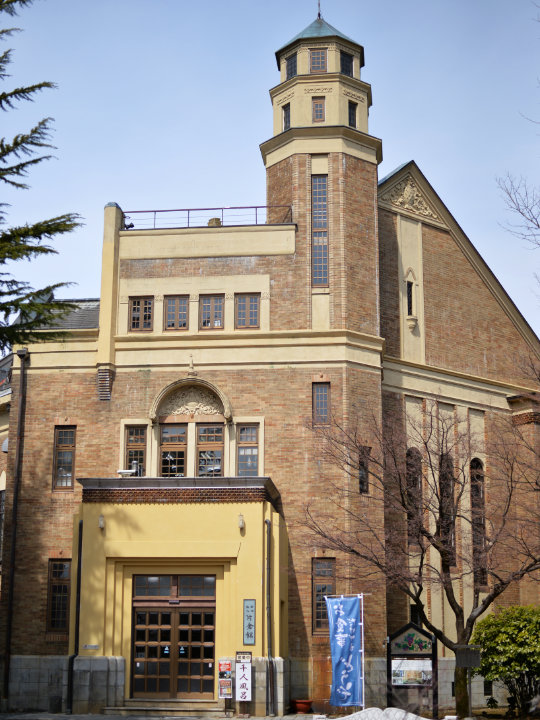
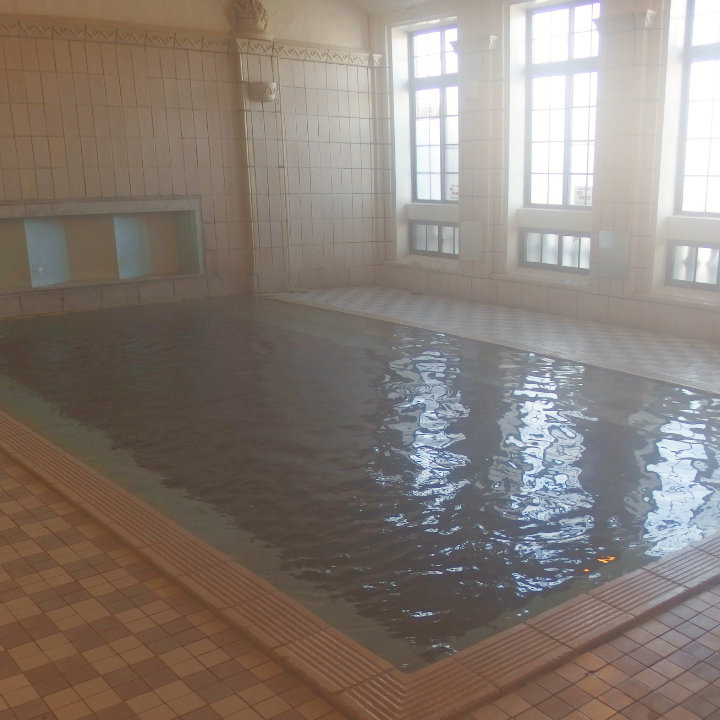
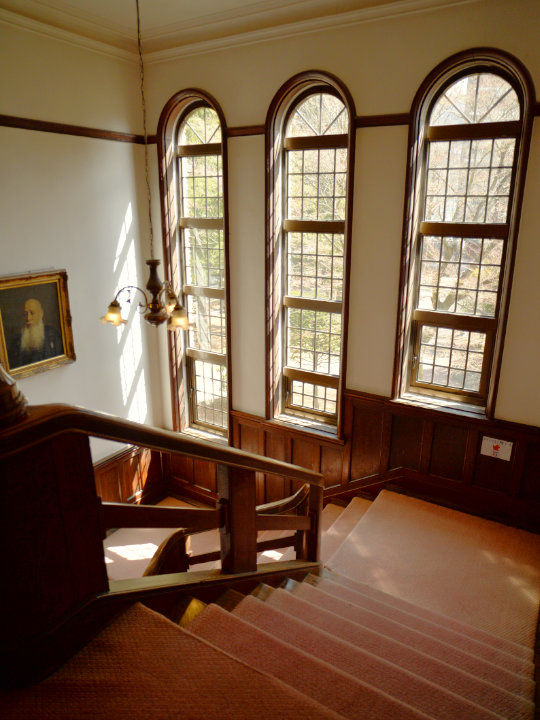
"Senninburo" means "one thousand people bathtub". It's a bathtub made of marble, 7.5 m (24.6 ft) long, 4 m (13.1 ft) wide, 1.1 m (3.6 ft) deep. The bottom is covered with pebbles, and when you stand, it stimulates your feet comfortably.
Katakurakan is a building completed in 1928 as a hall for welfare and socializing of local residents by the Katakura Business Conglomerate, which made a fortune in exporting silk products. The retro Western-style architecture is a nationally designated important cultural property.
Located on the shore of Lake Suwa, you can see the lake from the rooftop. It is very close to Kamisuwa Station and is definitely a must-see for sightseeing in Suwa.
- the description page
Location
Area / Railway
Ko-shin-etsu Region
Nagano Pref.
JR Chuo Line
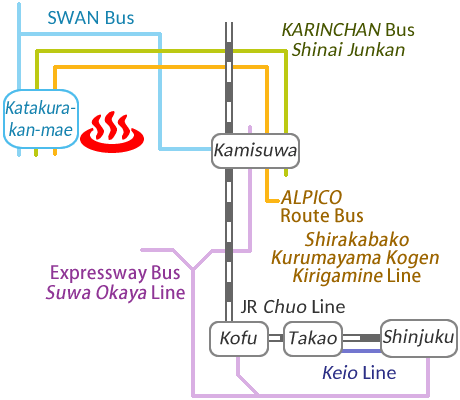
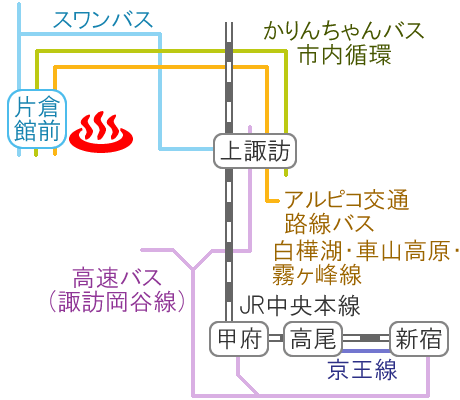
a station or bus stop to see timetable or detailed information
Bus timetables etc.
Route from Tokyo (Shinjuku)
- Shinjuku Sta.Keio: 1 hr Keio Line ¥370
- Takao Sta.JR: 3 hrs Chuo Line ¥2,640
- Kamisuwa Sta. (Suwako exit)Walk: 6 min 0.5 km (0.3 mi)
- Katakurakan
Route from Tokyo (Shinjuku)
- Shinjuku Sta.JR: 3 hrs 55 min Chuo Line ¥3,740
- Kamisuwa Sta. (Kirigamine exit) ※KARINCHAN Bus: 5 min Shinai Junkan Uchi-mawari Line ¥150
- Katakurakan-mae Bus StopWalk: 1 min
- Katakurakan
Route from Tokyo (Shinjuku)
- Shinjuku Sta.JR express: 2 hrs 20 min Azusa etc. Reserved-seat※¥5,980
- Kamisuwa Sta. (Suwako exit) SWAN Bus: 3 min Soto-mawari Line ¥150
- Katakurakan-mae Bus StopWalk: 1 min
- Katakurakan
Route from Tokyo (Shinjuku)
- Shinjuku Sta. (New South Gate) Walk: 2 min
- Shinjuku Expressway Bus Terminal (4th floor) ※Expressway bus: 3 hrs 02 min Suwa Okaya Line ¥3,500
- Kamisuwa Sta. (Kirigamine exit)Walk: 1 min
- Station Rent-a-car in front of
JR Kamisuwa Sta.Bicycle rental: 5 min ¥500 for 2 hrs - - Katakurakan
Route from Nagoya
- Nagoya Sta.JR: 3 hrs 50 min Chuo-nishi Line ¥3,410
- Kamisuwa Sta.(The rest is the same as above)
Route from Nagoya
- Nagoya Sta.JR express: 2 hrs Shinano etc. Non-reserved seat※¥5,610
- (Transfer at Shiojiri Sta.)JR: 25 min Chuo Line ¥ -
- Kamisuwa Sta.(The rest is the same as above)
Route from Nagoya
- Nagoya Sta.Walk: 5 min
- Meitetsu Bus Center (3rd floor) ※Expressway bus: 2 hrs 55 min Matsumoto Nagano Line ¥2,800 - ¥3,800
- Naganodo Okaya Bus StopWalk: 35 min 2.6 km (1.6 mi)
- Arayashiki Bus Stop SWAN Bus: 48 min - 1 hr 06 min Uchi-mawari Line (or Soto-mawari Line) ¥150
- Katakurakan-mae Bus StopWalk: 1 min
- Katakurakan
Routes from Tokyo
- Shinjuku
- Keio
- Takao
- JR
- Kamisuwa
- Walk

4 hrs 06 min ¥3,010
- Shinjuku
- JR
- Kamisuwa
- Bus

4 hrs 01 min ¥3,890
- Shinjuku
- JR express
- Kamisuwa
- Bus

2 hrs 24 min ¥6,130
- Shinjuku
- Expressway bus
- Kamisuwa
- Bicycle rental

3 hrs 10 min ¥4,000 -
Routes from Nagoya
- Nagoya
- JR
- Kamisuwa
- (The rest is the same as above)
3 hrs 50 min+ ¥3,410+
- Nagoya
- JR express
- Shiojiri
- JR
- Kamisuwa
- (The rest is the same as above)
2 hrs 25 min+ ¥5,610+
- Nagoya
- Expressway bus
- Naganodo Okaya
- Walk
- Arayashiki
- Bus

4 hrs 24 - 42 min ¥2,950 - ¥3,950
- The price of JR Express is "Basic fare" plus "Express charge."
(These are determined according to the distance.)
In case of JR Express "Azusa" and "Kaiji" on the Chuo Line, "Express charge" has two types: "Reserved seat" and "Undecided seat."
Both have the same charge, which is no difference depending on the season.
However, the price will vary depending on where you buy. (Internet < Station < Inside the car).
If you have an "Undecided seat" ticket, you can sit in any vacant seat, but you have no priority. So, if someone comes who has the "Reserved seat" ticket for the seat you are sitting, you have to give it up to him/her. - Other JR Express than the above, "Express charge" has two types: Reserved seat and Non-reserved seat. Reserved seat charge adds ¥930 (busiest season), ¥730 (busy season), ¥530 (normal season) or ¥330 (off season) to Non-reserved seat charge. (For details, please refer to JR East_Ticketing and Busiest / Busy / Normal / Off season calendar.)
- The Kamisuwa Station exits are called "Kirigamine exit" on the east side and "Suwako exit" on the west side. To go to the Suwako exit, you have to exit from the Kirigamine exit, go to the right, and cross the track with the overpass (connecting passage).
- KARINCHAN Bus and SWAN Bus sell one-day unlimited ride ticket (¥300 for adults) on the bus.
- On the Expressway Bus Suwa Okaya Line, some buses are operated in the order of Chuodo Chino → Okaya Sta. → Shimosuwa Sta. → Kamisuwa Sta. (last stop). Note that they take a lot of time to go to Kamisuwa Sta.
- The above fares are based on cash. When using an IC card, the fares may differ slightly.
- The above times and distances are approximate. Does not include transfering or waiting times.
Informations about Hot spring travel
- JR East (East Japan Railway) website
- JAPAN RAIL PASS guidance(JR GROUP)
- Route Search (Japan Transit Planner)
- Japan Route Finder & Planner (NAVITIME)
- Japan Train Timetable Searcher (NAVITIME)
- Expressway bus Search & Book(kosokubus.com)
- Shinjuku Expressway Bus Terminal
- Suwa City BusKARINCHAN Bus(Suwa City)
- Lake circulator busSWAN Bus (Suwa City)
- Route busSuwa area(ALPICO Kotsu)
- Taxi phone listSuwa City(Mapion)
- Taxi fare calculatorKamisuwa Sta.(taxisite)
- Rent-a-carReservation(TABIRAI)
- SuwaTouristAssociation
- SuwaTourismNavigation
- Suwa 5-Kura Tour (Brewery-hopping)
- Hotel / RyokanKamisuwa Onsen(Booking.com)
- Weather forecast Suwa City(WN)
- Weather forecast Suwa City(WeatherNews)
- Weather forecastSuwa City(AccuWeather)
Travel journal of dropping in at the hot spring
Characters
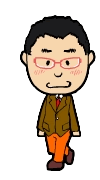
- Nishi-san
- He is an orthodox hot springs lover and particular about quality of springs. He loves the hot springs flowing from the source, the hot water with a presence, and the rustic atmosphere.
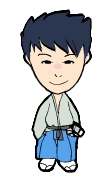
- Kita-san
- He doesn't care much about quality of hot springs. He loves an open-air bath, and prefers hot springs that have visible features such as good views.
Today, Nishi-san and Kita-san have been in Kamisuwa Onsen where on the shores of Lake Suwa. They've started walking to Katakurakan from JR Kamisuwa Station.
By the way, Katakurakan is often mentioned in Suwa's tourist informations, but what is the highlight?
The architecture seems to be pretty interesting. And, the Senninburo here is famous, so I wanted to go there once.
Boy, Senninburo ... Does it mean 1,000 people can get in it at a time?
Well, I'm not sure.
They have arrived at Katakurakan.
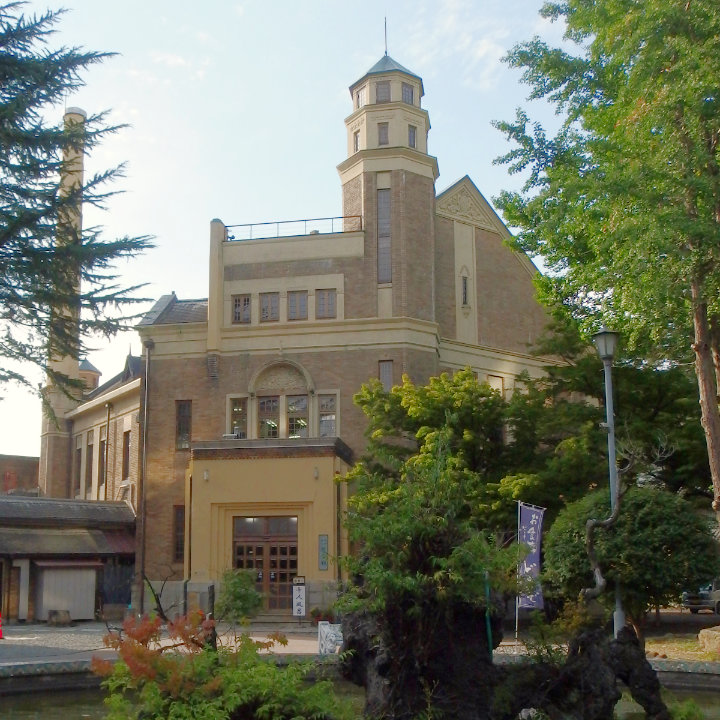
Katakurakan (Bathhouse) exterior
Wow, this is it! How can I explain it? It's a fairy tale building! Or it looks to appear in girls manga. When was it built?
Taisho era, or the beginning of Showa era, I think.
Then, when Western-style architecture was still rare. No, it may not have been rare in Tokyo, but in Suwa it was rare, you know.
Still, it seems to have been arranged in a Japanese way. And, the public bath was made inside and opened up for locals, so it was so novel at that time, I guess.
That makes sense. If you say so, this design might be unique.
Right away getting into Katakurakan. The reception is in front and the men's bath is on the right. Nishi-san and Kita-san are heading to the undressing room.
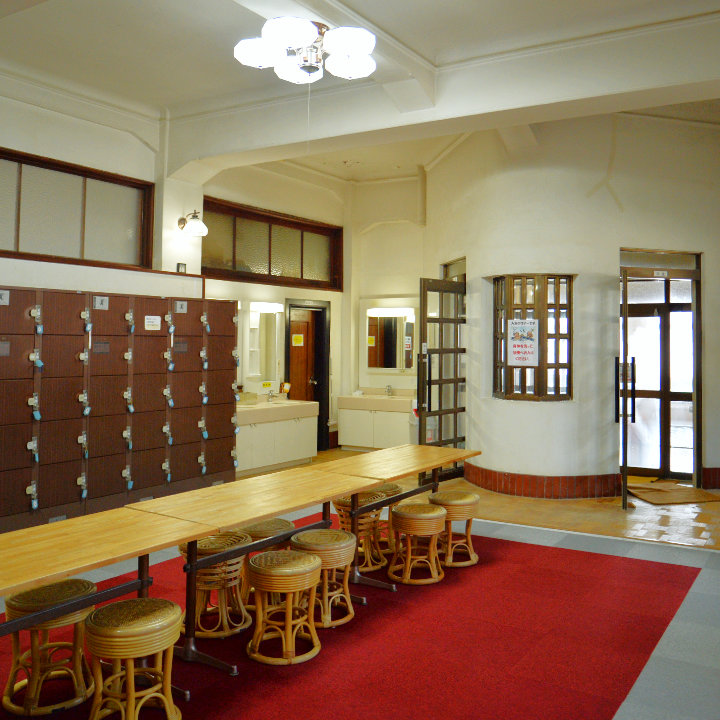
Undressing room
Oh, a little retro feeling?
It has a nice atmosphere.
The bathing room has a washing area on the right and a jacuzzi on the left. But, The first thing that jumps into your eyes is the large bathtub "Senninburo" located in front.

Senninburo
(1,000 people bathtub)
Oh! This is Senninburo! It's pretty big, you know. And really bright.
Exactly. It has a different taste from Japanese hot springs. It might be including some of the longing for the West.
They soak in the bathtub at once.

Senninburo
(1,000 people bathtub)
Oh, deep! And what is this? Stones?
It's true. Pebbles are covering the bottom. It's like the effect of stepping on bamboo.
You mean I can massage the pressure points on my feet just standing and walking?
In short, the concept is to be healthy while taking a bath.
I got it. It's a kind of exercise rather than laid-back soaking in hot water. By the way, even though it's called 1000 people bathtub, 1000 people will not be able to soak in here. Absolutely impossible.
♨ Katakurakan was completed in 1928. As the architectures at the same period, Imperial Hotel designed by Frank Lloyd Wright was 1923, and Hibiya Public Hall was 1929.
Exactly, 1000 people can't get in.

Staircase
After the bathing, they're walking and looking around the inside of Katakurakan Bathhouse. Up the stairs, there is a break room and a dining room on the second floor, and you can go up from there to the rooftop.
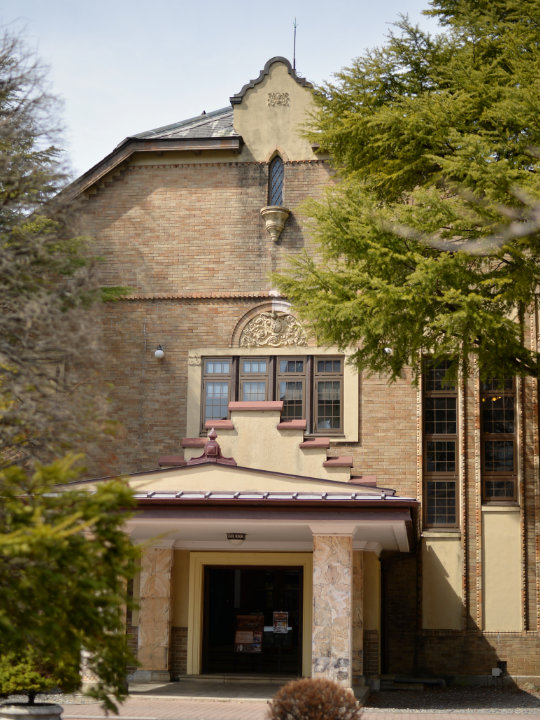
Katakurakan (Hall) exterior
After taking a look at the Bathhouse, they go to visit the Hall next. For tours without a guide of Katakurakan Hall, you don't need to make a reservation. In that case, you can feel free to look around after receiving the explanation of the route.
It's Western style to the entrance, but it's Japanese style from the back of this corridor. I think also the Former Furukawa House in Komagome has Japanese-style rooms. In this era, many buildings might have been built with a mixture style of Japanese and Western.
Oh, I see ... Ah, they explain about Senninburo on this information board. It says ... What? It says 1000 to 1200 people use it in a day ... Senninburo means a total in a day?
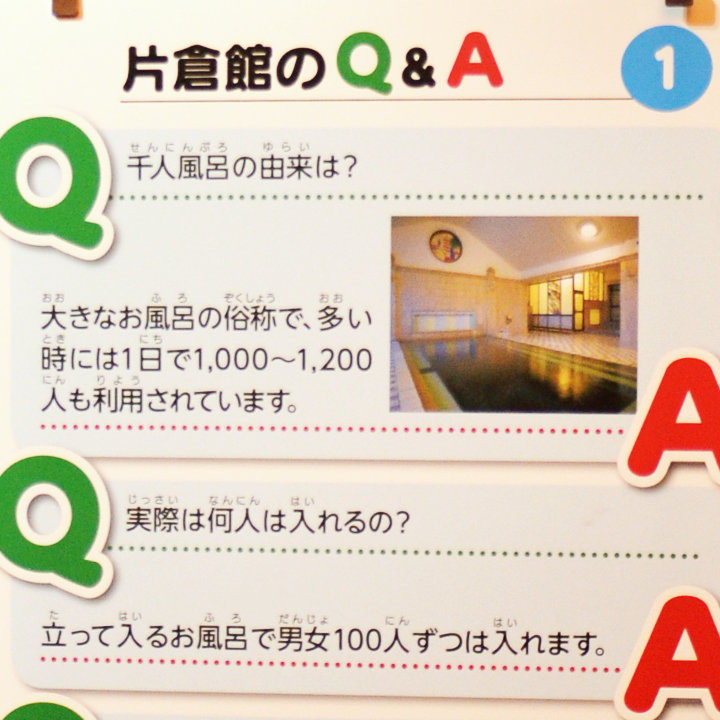
Information board
In short, it means a large bathtub. Actually, it says just a hundred people can get in it at a time.
Then, that should be called one hundred people bathtub, you know.
Could be. Then next, let's go up to the second floor.
OK!
♨ The 7.5 m (24.6 ft) x 4 m (13.1 ft) area is about 18 tatami mats.
♨ The Former Furukawa House in Tokyo was designed by Josiah Conder and completed in 1917. (For details, see Otani Museum)
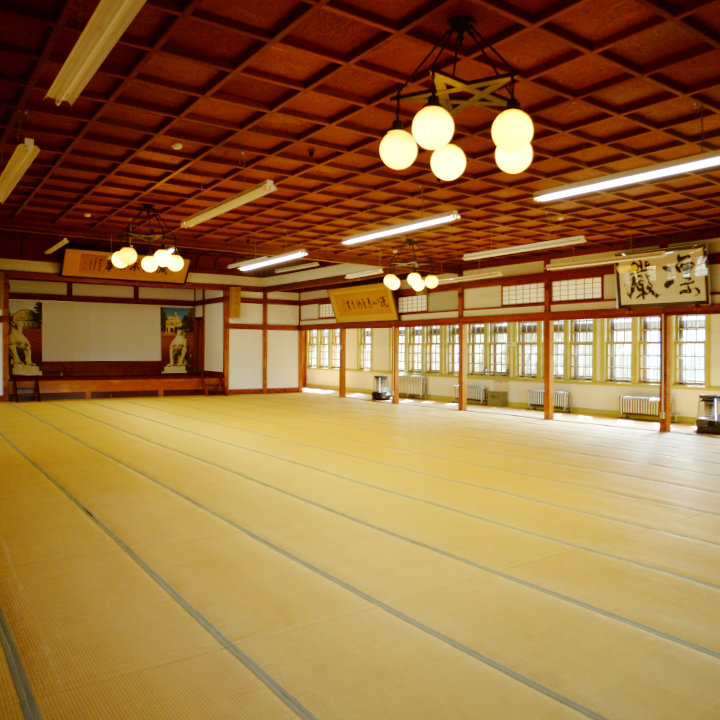
Large hall
It was the Katakurakan tour which had some highlights, such as the 200-tatami hall and looking for the relief of "Guardian Bear". Nishi-san and Kita-san were satisfied with the fulfilling experience. (→ Continue to Kamisuwa Onsen Shibunoyu)
(September 2018)
♨ Other than Katakurakan, Shimoda in Izu and Sukayu Onsen in Aomori Prefecture also has the bath called "Senninburo".
Impression & rating
The hot water has no feature. But here it's better to enjoy the building and the atmosphere than hot water.
1.0 pt
Impression & rating
Important cultural property buildings and unique bathtub are interesting in the sense that the out of the ordinary experiences.
2.0 pt
The Onsen facility
- Address
-
4-1-9, Kogandori, Suwa City, Nagano Pref.
- Phone
-
domestic: 0266-52-0604
international: +81-266-52-0604 - Website
- Katakurakan
- Bathing hours
-
10:00 - 21:00
(Last entry at 20:30) - Closed day
- 2nd and 4th Tuesdays
- Admission fee
-
Adults: ¥750 /
3 years old or older and Elementary school students: ¥450 - Baths
- Gender-separated indoor bath
- Facilities
- 100 yen coin required for shoes box and undressing room locker (return type)
The hot spring data
(According to the hot spring analysis report etc.)(Field examination date: May 14, 2018)
- Spring quality
- Simple hot spring (Hypotonic Weak alkaline High temperature spring)
- Source
- Nanatsugama hot water distribution center (Mixed spring of Mitsugama No.1, Mitsugama No.2, Ayame and Yannami source)
- Gushing place
- 2-208-90, Kogandori, Suwa City, Nagano Pref.
- Temperature
-
63.0 ℃ (145.4 ℉)
[air temperature: 23 ℃ (73.4 ℉)] - Water volume
- - L / min
- pH value
- 8.28
- Total ingredients
- 0.5714 g / kg
- Perception
- Almost clear and colorless, slightly salty
Today's Detour
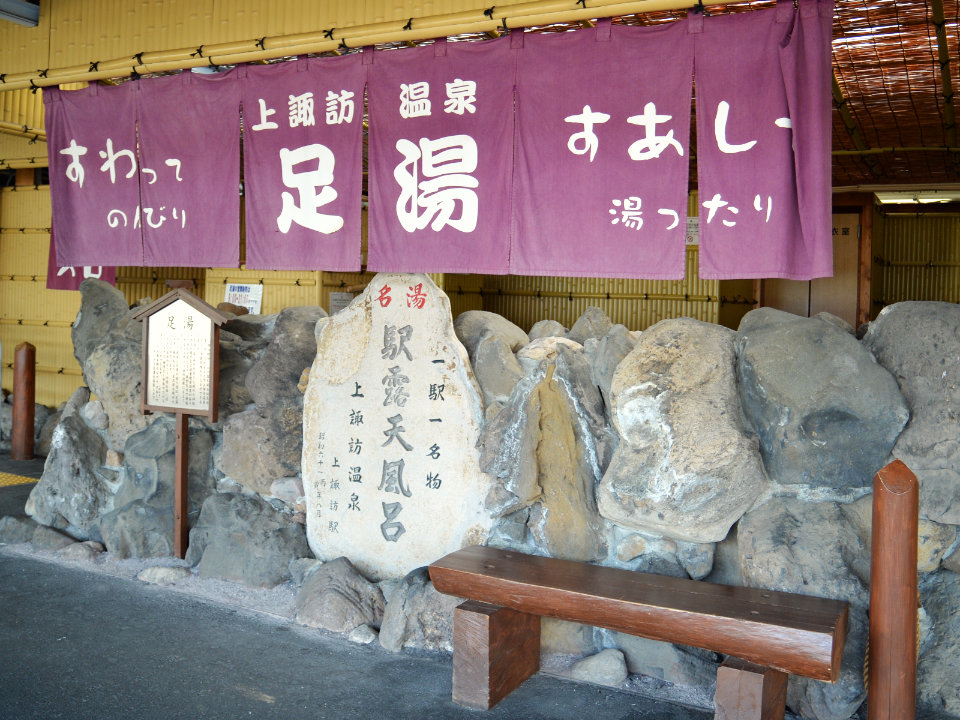
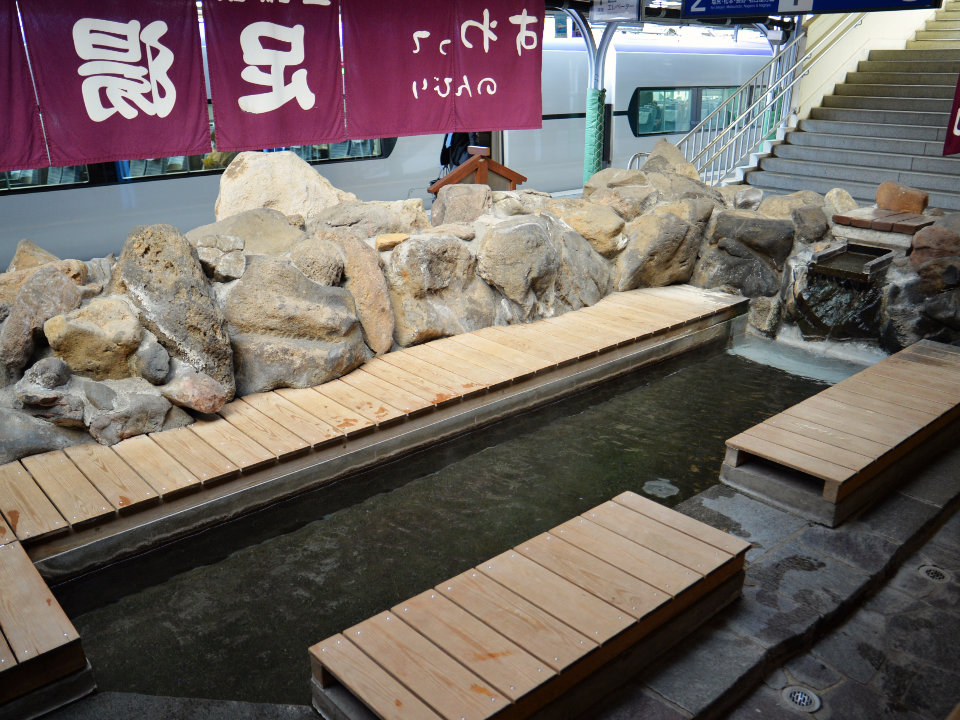
Footbath in Kamisuwa Station
Kamisuwa Station has a footbath on the platform.
You can use it on free of charge in a short time while waiting for your train.
For train lovers and hot spring lovers, it's like a dreamland where you can enjoy a hot spring while watching the passing trains.
[Open year round 9:00 - 21:00]
- The descriptions on this page contain personal opinions and are not necessarily objective facts.
- The information may have changed at present. In particular, the admission fee and charge etc. has often not updated from the time of travel, so check the latest information on the official website.




